|
A Trip To The Louvre In Atlanta
By Mike McLeod
Before the High Museum brought to Atlanta the exhibitions, "The Louvre and
the Ancient World" and "The Eye of Josephine," I never thought I would see any
of the masterworks in the Louvre's collection. I expected the closest I would
ever get to that grand museum was seeing it in the movie, The DaVinci Code.
However, approximately 130 artifacts and artwork will be on display at the
High Museum for the next few months. The "Louvre and the Ancient World" features
works from Egypt, the Near East, Greece and Rome dating from the Third
Millennium BC through the Third Century AD. The "Eye of Josephine" exhibit
includes 60 works from the collection acquired by Napoleon's first wife, the
Empress Josephine. This includes antiquities from Pompeii and Herculaneum given
to her and Napoleon in 1802 by Ferdinand IV, the King of Naples. Josephine
displayed her Egyptian sculptures and Greco-Roman marbles, bronzes and vases in
her home near Paris until her death on May 29, 1814. After that, her collection
was dispersed to the winds. Then in the mid-1800s, it was acquired piecemeal by
the Louvre. Later, experts tracked down the individual pieces in the Louvre and
reassembled Josephine's collection.
The exhibits are displayed in three
rooms in the High Museum, and from the beginning, it starts off with a bang
the marble sculpture The Tiber. This 10-foot-long masterpiece depicts the river
god Tiber holding an oar and a cornucopia, representing the fruitfulness of the
river in providing food and water. Romulus and Remus are also in the sculpture
as babies with the she wolf who nursed them because, as the legend goes, they
were left on a bank of the Tiber River where the wolf found them.
|
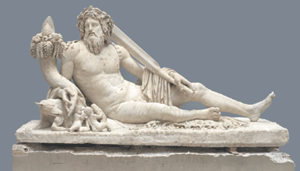
|
The Tiber by an unknown artist, ca. 100 AD. |
The
magnificence of this work by an unknown artist in circa 100 AD is only done
justice by observing it in person. I imagine it is akin to seeing the David
sculpture by Michelangelo which stands an overshadowing 14 feet tall. The size
and the workmanship of the Tiber are likewise overwhelming especially when
considering how the artist must have first approached a giant block of marble
and began hammering away, steadily removing layers and chips of rock until the
god slowly emerged. The detail of the work from the carving of a leaf and
bunches of grapes to the laurel wreath on Tiber's head is absolute
mastery.
This work of art is not protected behind glass so you can observe it
from a distance of mere inches.
Tearing myself away for the moment (I later
returned to gaze at The Tiber longer), I moved on to the other exhibits which
were on the floor above. Starting with "The Eye of Josephine" exhibit, it
includes furniture, paintings, pottery and some of the above-mentioned
antiquities from Ferdinand IV. Perhaps the most interesting of the furniture is
Napoleon's tri-legged washstand made of yew, gilt bronze and silver. The Emperor
used it in his bedchamber in the Tuileries Palace in Paris and later took it
with him into exile on the island of Saint Helena. Another remarkable piece is a
glazed brick portrait of an archer which graced the palace walls of Darius the
Great (522 BC-486 BC), King of the Persian Empire. Darius is known for uniting
and lengthening the Persian Empire to its greatest extent, as far as the Indus
Valley in Pakistan and India. The molded polychrome-glazed bricks depict an
archer armed with a long spear, a bow and quiver. It was one of a series of
archer figures on the palace walls.
Along with these items is a grouping in
one room of pottery, paintings and one of Josephine's chairs. The wood and
fabric wrap-around chair was created in 1808 by Michel-Jacques Boulard. The
chair's fabric is off-white in color and in near-perfect condition, considering
it is 200 years old. The entire piece from the pine cone feet to the
hand-carved neck rest is remarkable, even without considering that Josephine
and probably Napoleon sat on it.
The rest of Josephine's collection is
interspersed with the "The Louvre and the Ancient World" exhibit. These works
vary from the sublime to the everyday to the unexpected. The sublime works
encompass mural fragments from Pompeii of the Muses, and also Greek and Etruscan
kraters painted with mythological scenes. The murals depict 12 of the 13 Muses,
which were goddesses or spirits embodying the inspiration for the arts, music,
dance, writing and so on.
One everyday item (I am assuming it was an
everyday item in Roman times) was an L-shaped piece of metal. It was used to
scrape mud off the body before getting into the public baths. This was a handy
tool since muddy bodies clouding the water in public baths would be very
annoying.
The unexpected item was a cat sarcophagus from Egypt. Made of wood
and carved in the shape of a cat sitting on its haunches, the piece was hollow
and at one time contained a mummified cat.
More than a dozen large kraters
were on display, all characteristically black with black figures painted on a
rectangular background of reddish-orange. Creating these works of art was a
magical feat.
Wikipedia.com describes the creation of black figure pottery
this way:
"The design was sketched in outline, then filled in using refined
clay as paint. Details would be added with an engraving tool, scratching through
the paint layer to the clay below. The vessel would then be fired in a kiln at a
temperature of about 8000C, with the resultant oxidation turning the vase to a
reddish-orange color. The temperature was then raised to about 9500C with the
kiln's vents closed and green wood being added to remove the oxygen. The vessel
then turned an overall black. The final stage required the vents to be reopened
to allow oxygen into the kiln, which allowed it to cool down. The vessel then
returned to its reddish-orange color due to renewed oxidization; while the
painted layer remained the glossy black color created in the second
stage."
Also on exhibit are red-figure kraters from Josephine's collection.
Red-figure pottery replaced the earlier style of black-figure pottery around 500
B.C. because it allowed for more detail in the drawing. The opposite color
effect of creating red figures was achieved by keeping the final firing to a
lower temperature rather than raising it. The lower temperature kept parts of
the vase from re-oxidizing and changing colors so the figures remained
reddish-orange.
Kraters are exquisite works of art, requiring the creator to
be an accomplished potter and a masterful painter. Consequently, they are
considered national treasures. Recently, the Metropolitan Museum of Art returned
a 2,500-year-old krater by the Greek artist Euphronius to Italy. It was
purchased by the Met in 1972 for $1 million from an American art dealer who just
happens to be on trial now in Rome for dealing in stolen artifacts.
There
are several excellent carvings in stone from Rome and Egypt, such as an
engraving of Ramses II, but one stands out above the rest: a bust of Lucius
Verus, the brother of Marcus Aurelius, from ca. 161 AD. (The brothers co-ruled
Rome from 161 AD to 169 AD which was atypical of the Roman style of government.)
Each curl of Verus' hair and beard was individually drilled into the marble to
create a highlight of light and shadow. An artist friend once told me that he
learned a lot about eternity when he drew a very large eagle with just pinpoint
dots, no lines. The sculptor who created this magnificent work must have had
some of the same feelings as he worked on Verus' hair and beard day after
day.
"The Eye of Josephine" will be on display through May 18th of this year,
and "The Louvre and the Ancient World" is at the High Museum until September
7th. Unless you are planning to visit Paris, you don't want to miss a chance to
take a trip to the Louvre in Atlanta.
Note: In November, the
High will host China's Terracotta Army 23 life-size figures and nearly 100
objects, the largest grouping of these objects China has ever loaned.
The
High Museum is located at 1280 Peachtree Street in Atlanta. It is open: Tuesday,
Wednesday, Friday and Saturday, 10-5; Thursday, 10-8; Sunday, noon-5; and closed
on Monday. For information, call 404-733-4550.
Photos of the bust of
Lucius Verus, Greek Attic amphora, cat sarcophagus, the Poetry Muse, Hercules,
goddess Hathor and The Tiber are by Peter Hardholdt and are reproduced with
permission from the Musée de Louvre, Paris/High Museum of Art, Atlanta.
|
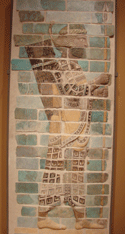
The Archer mosaic from the palace of Darius the Great (522-486 BC),
polychrome-glazed brick.
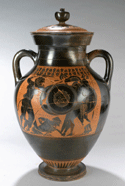
Greek Attic amphora with black
figures, signed by Exekias and found in
Italy, 550-540 BC.
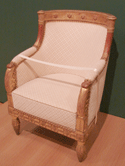
Josephine's chair by Michel-Jacques Boulard, 1808.
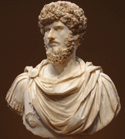
Masterfully-carved marble bust of Roman Emperor Lucius Verus, ca. 161 AD.
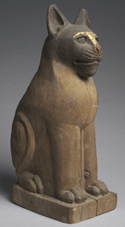
Egyptian cat sarcophagus of gilded and painted wood, Ptolemaic Period,
715-332 BCE.
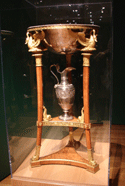
Napoleon's ornate bedchamber washstand made of yew, gilt bronze and
silver.
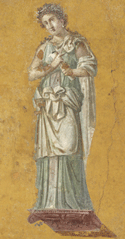
Calliope, Muse of Poetry, 62-79 AD, mural fragment from Josephine's
collection.
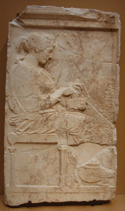
Funerary stele for the grave of a young woman named Philis; Greek,
ca. 450
BC.
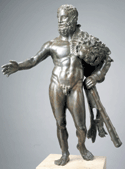
Josephine's Hercules, bronze with eyes of inlaid silver, 24 1/2 in., before
79 AD.
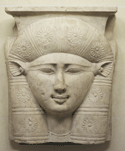
Head of the goddess Hathor,
332-30 BCE.
|